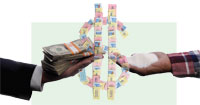A Taste of Sugar Economics
By Jo Lynn Orr
 By any measure, sugar is big business. According to the latest figures from the American Sugar Alliance, the sweetener industry creates some 372,000 jobs, directly or indirectly, in 42 states and contributes as much as $21 billion to the American economy each year.
By any measure, sugar is big business. According to the latest figures from the American Sugar Alliance, the sweetener industry creates some 372,000 jobs, directly or indirectly, in 42 states and contributes as much as $21 billion to the American economy each year.
Despite this sugar-producing prowess, however, the United States is the world’s second-largest importer of sugar. That leaves American producers with a bitter taste in their mouths, but some policy analysts argue that it is in the country’s best interest to import even more. At its core, this sour debate is really about one of the thorniest topics in international trade: government subsidies.
American sugar farmers, who are not subsidized by taxpayer dollars, say they are getting a raw deal. They claim that heavy subsidies and other pro-producer policies are prevalent elsewhere in the world, which creates an unequal global trading field and hurts American jobs. But this line of argument hinges on semantics, says UAB public policy expert Nikolaos Zahariadis, Ph.D. While it is true that the U.S. government does not support American sugar directly, he explains, it does use tariffs to restrict imports of cheaper foreign sugar, primarily from Cuba. “So we’re artificially keeping the price of sugar higher than it should be. Technically, we’re not subsidizing it, but practically, we are.”
UAB economist Sara Helms, Ph.D., says that the classic view of tariffs in her profession is that they’re not a good idea. “If we protect sugar producers with tariffs, then consumers lose,” she says. “Economic balance is hard. Invariably some people will gain and others lose, but in the bigger picture, we all gain from lower prices and free trade.”
The consequences of government intervention, whether in the form of subsidies or tariffs, are also difficult to predict, Zahariadis notes. In the sweetener market, a prime example is corn. That golden grain is, not surprisingly, a primary ingredient in high-fructose corn syrup, which accounts for nearly half of our annual consumption of sweeteners. But farmers today are much more interested in turning their corn into ethanol, a gasoline substitute that is fetching them record earnings thanks to government support. “That’s likely to have a tremendous impact, especially now with the price of gas so high,” says Zahariadis. “Quite a few farmers are dropping other crops and starting to produce corn because they can get more money.”
As more corn is turned into ethanol, less is available to be transformed into corn syrup, and that means that the cost of many sweetened foods—everything from soft drinks to sausages—may rise, Zahariadis says.
Yet the power of producers to sway prices may be on the wane. Zahariadis points out that many of today’s sweeteners, such as NutraSweet and Splenda, are synthetic creations that bypass both sugar and corn farmers entirely. “The more we create all of these food substitutes, the less important sugar becomes in its traditional form,” he says. “The availability of substitutes will actually make sugar over time less relevant to us than before.”
Back to main article